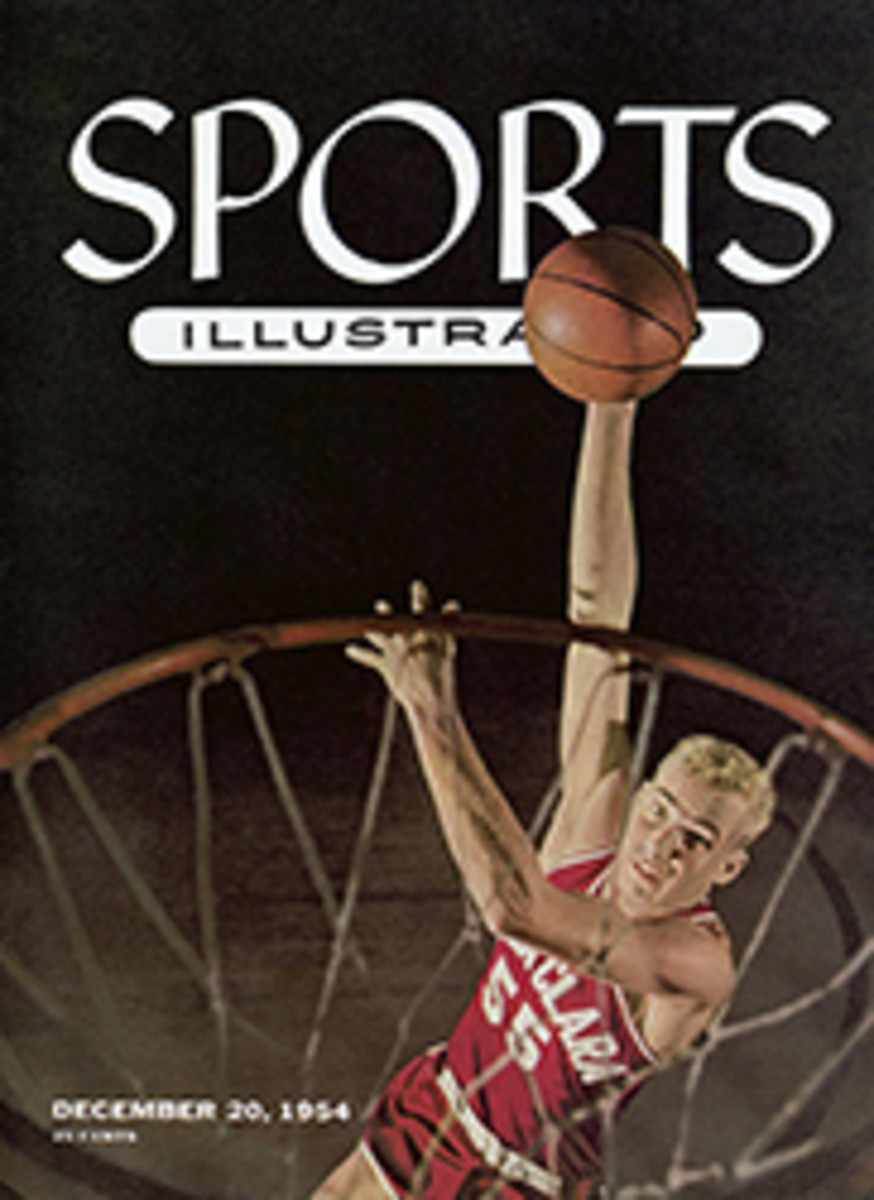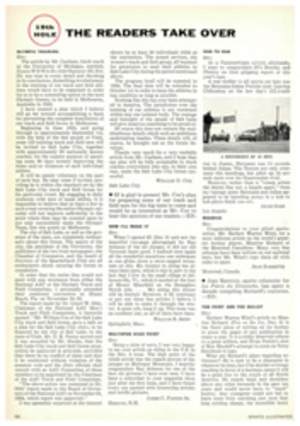
FORGET SOMETHING, BOYS?
Eleven floors above the conference room in New York's Hotel Commodore, where the rulers of major league baseball met last week, a troubled man named George Trautman sat in his bedroom and talked. On his dresser was a bottle labeled:
DORMIN
For the Relief of Insomnia
George Trautman's trouble and his insomnia stem from a common source. Trautman is president of the National Association of Professional Baseball Leagues—the minors.
For two days major league magnates talked of expansion, of new cities, of California gold. The American League set up a committee to see what can be done, over the next year or two, about adding teams on the Pacific Coast. The National League, confident that it has a foot in the California door already, kept its counsel.
The minors? They were mentioned at the meetings. The major leaguers agreed to invest a bit more money in clubs with which they had working agreements—and from which they draw nearly all their talent. The majors refused to vote a ban on telecasting or broadcasting their games into minor league cities. "We couldn't," one magnate explained confidentially. "Restraint of trade."
Before the 1954 major league meetings began, the fast-folding minor leagues were baseball's most pressing problem. When the meetings were over, the minors remained baseball's most pressing problem.
"Sure," said an angry minor league official as he prepared to head home, "the magnates haven't done much in 50 years. You can't expect them to do anything in two days."
After more than 50 years of meeting, the major leagues' winter session has come to resemble, in broad outline, a convention of the American Dried Fruit and Pecan Nut Packers Association. There are industry-wide problems to be faced and the captains of industry sit at conference tables apparently facing them. This year baseball's captains actually faced very little.
On the first day of the meetings—Monday—the American and National Leagues met separately. The American League launched a study of expansion. The National League voted to bar press photographers from working on the field during games and dealt with matters of similar moment.
CHATTER IN THE LOBBY
Tuesday the leagues met in joint session and spent the morning voting down the minor league request that TV and radio be limited. The owners began leaving town Tuesday afternoon.
Some player trades had been made. With so many baseball men so close together, trades invariably evolve. While the owners met in conference rooms, managers and lesser officials spilled into the lobby, talking baseball and setting up deals, as they stood under team flags displayed by the Commodore in honor of the clubs that stop at that hotel on trips to New York during the season.
But the story of the major league meetings was not, as it had been in other years, somewhere in the lobby. It was not, as it has been, in the conference rooms. It was not even in George Trautman's suite. Rather, the story unfolded in many places; a story of baseball galloping off in two directions at one time.
The minor leagues are vanishing. Twenty-six leagues have disappeared since 1949, the minors' peak year, and holes have opened in the U.S. baseball map like the holes in a well-aged chunk of Swiss cheese.
There was the Mountain States League and the Central League, the Inter-State League and the Sunset League, the Lone Star League, the New England League, and, to break the meter, the K.O.M. League (Kansas, Oklahoma, Missouri) and the Wisconsin State League. All have blown away. With them have gone some of baseball's notable minor league towns: Sheboygan, Wis., Nashua, N.H. (where the Dodger battery of Don Newcombe and Roy Campanella broke into organized baseball eight years ago), Ponca City, Okla., Flint, Mich., Zanesville, Ohio. They get baseball only by radio and TV now.
Meanwhile the major league owners talk of spreading talent, already spread thin, still further.
That's pretty much what George Trautman discussed while the rulers of baseball discussed other things eleven floors below. "We have not yet met present conditions with progress," Trautman said. "That's the trouble."
It is possible the collapse of so many minor leagues is a reflection of a change in American habits—a preference for network TV talent to minor league baseball talent. If that be so, then only direct major league subsidy can enable the minors to survive and preserve the present structure and caliber of baseball. Without subsidy, all that can be asked is neat chisel work on minor league monuments by the man who carves: Requiescat in pace.
According to Trautman, neither a chisel nor a subsidy is needed. "We just have to make our product more attractive," he said.
"After the war," Trautman explained, "we had our boom. At one time there were 59 minor leagues. That's more than there should have been because we got careless. Almost any eight men who came to see us with cities got a league. We didn't consider financial stability. That's one thing we're paying for now."
Trautman thinks the situation will get better as more draftees are released—2,300 minor leaguers are now in the service. He thinks a flaw that is correctable exists in those leagues which include both local independent franchises and major league farm clubs because farm clubs often have far better players and produce lopsided races. He points to surveys proving—surveys always prove—that people outside major league areas are still interested in minor league baseball. He points to enlightened minor league promotion, to destruction of the myth that minor league players starve, to better balanced leagues, all as potential steps in the right direction.
"Out yonder," Trautman said, pointing west, "the minor leagues are reaching a point where they're going to be more successful. There's better promotion right now, and more hustle by the clubs to get out the fans. That'll make the leagues go."
Anyone with the faintest interest in the preservation of baseball must hope that Trautman is right. Unfortunately, the magnates did nothing more than hope, either.
Trautman and the minors have been left to shift for themselves. It looks like a banner year for the makers of DORMIN—For the Relief of Insomnia.
ILLUSTRATION
WILLIAM SHARP
TROUBLED GEORGE TRAUTMAN DISCUSSES MINORS' WOES IN HIS ROOM
TWO ILLUSTRATIONS
WILLIAM SHARP
TWO MANAGERS, Chuck Dressen of Washington (top) and Lou Boudreau of Kansas City, were among 13 big league pilots who came to meetings. They had no formal duties, but held luncheon, swapped tales, talked trade. Two trades were made.
ILLUSTRATION
WILLIAM SHARP
MEYER
O'MALLEY
PAUL
FEENEY
CARPENTER
QUINN
GALBREATH
GALLAGHER
PRESIDENT GILES
COMMISSIONER FRICK
PRESIDENT HARRIDGE
LANE
GRIFFITH
WILSON
CRONIN
BRIGGS
YAWKEY
JOHNSON
EHLERS
COMISKEY
GREENBERG
TOPPING
WEISS
WEBB
ABOUT THE DRAWING
Artist William Sharp re-creates the joint meeting of the major leagues. In the National League group are Brooklyn's Walter O'Malley, St. Louis' Dick Meyer, New York's Charles Feeney, Cincinnati's Gabe Paul, Milwaukee's John Quinn, Pittsburgh's John Galbreath, Philadelphia's Bob Carpenter, Chicago's Jim Gallagher, Pres. Warren Giles.
The American League group consists of President Will Harridge, Chicago's Frank Lane and Chuck Comiskey, Washington's Cal Griffith, Cleveland's Myron Wilson and Hank Greenberg, Boston's Joe Cronin and Tom Yawkey, Detroit's Spike Briggs, Kansas City's Arnold Johnson, Baltimore's Art Ehlers, New York's Dan Topping, George Weiss, Del Webb. Ford Frick presides.

